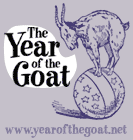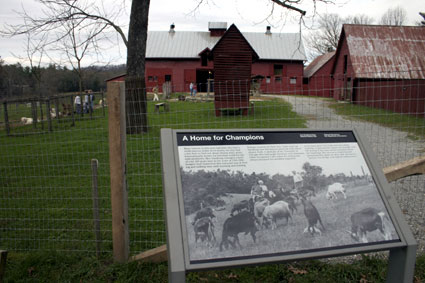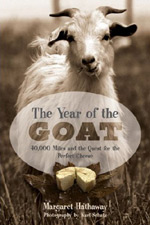About an hour south of Asheville, in the little town of Flat Rock, North Carolina, sits Connemara Farm. The former home of Carl and Lillian (Paula) Sandburg, the farm is now run by the National Park Service, and is the only home of an American writer to enjoy the distinction of being named a
National Historic Site.
While we greatly respect Carl Sandburg's work, it was actually his wife who drew us to Flat Rock. Between 1935 and 1966, Paula Sandburg (who, incidentally, was the sister of photographer Edward Steichen) raised champion dairy goats. Beginning her herd for practical reasons when Carl was a struggling poet in Michigan, Paula became fascinated by the possibilities of genetic manipulation. As her husband became successful as a writer, she grew to national prominence as a dairy goat breeder. By the time they moved to North Carolina in 1945, Mrs. Sandburg was famous in her own right for her goats.
She called her animals the Chikaming herd, and it included Nubians, Saanens, and Toggenburgs. What interested Mrs. Sandburg most was breeding for production; in addition to raising the goats, she ran a commercial dairy on the farm. At its peak, the Chikaming herd had about 200 goats, though now the National Park Service keeps it to about fifteen. Sue Hewlett, the volunteer we spoke with, said that they do make sure to keep Mrs. Sandburg's bloodlines in the current herd, though the management is not quite so rigorous. Since the farm is staffed primarily with volunteers, the kind of copious record taking for which Mrs. Sandburg was famed is no longer possible. They are also no longer milked, so the production level isn't gauged. Even so, they were beautiful animals.
When we visited, we were curious to know whether Carl Sandburg had written any poetry about goats. Though the couple was mutually supportive, each Sandburg seemed to be occupied independently. In the published correspondence of Carl Sandburg, there are myriad mentions of the goats, but in his poetry we could only find one, and the goat depicted seems to have a life antithetical to those lived by Mrs. Sandburg's animals. Maybe it was that contrast that struck him; we certainly found the juxtaposition interesting. —MMH
The sober-faced goat crops grass next to the sidewalk.
A clinking chain connects the collar of the goat with a steel pin
driven in the ground.
Next to the sidewalk the goat crops November grass,
Pauses seldom, halts not at all, incessantly goes after the grass.
—Carl Sandburg
from "Suburban Sicilian Sketches"


